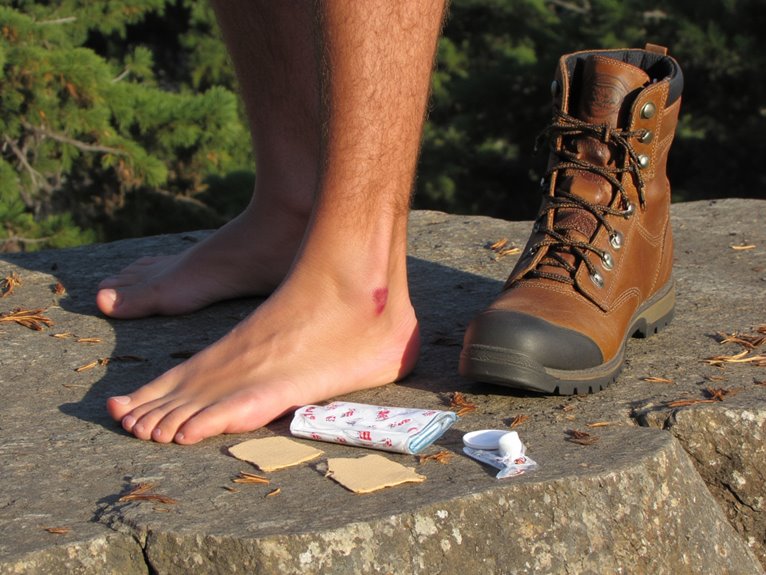How to Prevent and Treat Blisters and Hot Spots Using Your Footwear
You can prevent most blisters by ensuring proper shoe fit with thumb-width space between your longest toe and shoe front, plus correct width to prevent lateral foot movement. Choose moisture-wicking synthetic or merino wool socks while avoiding cotton, which retains moisture and increases friction. Apply friction-reducing balms to high-risk areas like heels and toes before activities begin. For existing hot spots, use hydrocolloid dressings immediately. These foundational strategies form the basis for thorough foot protection techniques.
We are supported by our audience. When you purchase through links on our site, we may earn an affiliate commission, at no extra cost for you. Learn more. Last update on 18th December 2025 / Images from Amazon Product Advertising API.
Notable Insights
- Choose shoes with thumb-width space between longest toe and front, proper width to prevent lateral movement and slippage.
- Select moisture-wicking synthetic or merino wool socks with dual-layer designs while avoiding cotton that retains moisture.
- Apply friction-reducing balms or medical tape to high-risk areas like heels and toes before activities begin.
- Use breathable, activity-specific footwear with dynamic lacing systems to reduce heat buildup and foot movement during motion.
- Treat existing blisters by cleaning with soap and water, applying hydrocolloid bandages, and monitoring for infection signs.
Understanding the Root Causes of Blisters and Hot Spots
Although they’re often dismissed as minor inconveniences, blisters represent a complex biomechanical response to multiple stress factors acting on your skin.
Proper friction analysis reveals that shear deformation—the back-and-forth stretching of skin layers—causes more damage than simple surface rubbing. Your feet experience peak stress during prolonged standing or walking, particularly at pressure points like heels and toes.
Shear deformation from repetitive skin stretching inflicts greater tissue damage than surface friction alone during extended weight-bearing activities.
Ill-fitting footwear creates the primary mechanical stressor. Shoes that are too tight or loose generate repeated shear forces against vulnerable skin areas. Proper fit is essential for blister prevention and overall comfort during extended wear.
Meanwhile, effective moisture management becomes critical since excessive perspiration softens your skin, making it more susceptible to friction damage. Wet conditions from sweat or external sources compromise skin integrity through maceration. Athletes particularly face elevated risk due to excessive moisture from intense physical activity. Advanced moisture-wicking technology in socks and footwear linings helps draw perspiration away from skin surfaces to maintain dryness.
Understanding these interconnected factors allows you to target prevention strategies at their biomechanical source. Importantly, these fluid-filled pockets serve a protective function by safeguarding underlying tissues and helping prevent infection.
Choosing the Right Footwear for Optimal Fit and Comfort
The foundation of blister prevention starts with proper footwear selection, where precise fit trumps brand loyalty or aesthetic appeal.
Proper shoe length requires a thumb’s width between your longest toe and shoe front, allowing foot elongation during movement. Measure while standing since feet lengthen under weight.
Correct shoe width prevents bulging beyond shoe edges while avoiding lateral movement from oversized footwear.
Adjustability features like dynamic lacing systems enable micro-fit changes during activity, preventing foot slippage and hotspots. Quality footwear materials featuring breathable, moisture-wicking fabrics reduce heat buildup and friction.
Softer uppers conform to foot contours, minimizing pressure points. For extended hiking activities, target a weight under 2 pounds per pair to reduce overall foot fatigue and friction-related hot spots.
Activity specific shoes account for impact forces and motion patterns unique to your sport. Trail shoes differ greatly from road running footwear in construction and protection levels, directly affecting blister formation risk.
Many quality hiking boots feature roomy toe boxes that accommodate thicker socks comfortably, reducing pressure points that commonly lead to blisters during extended outdoor activities.
Selecting Proper Socks for Maximum Protection
While proper footwear forms your first line of defense against blisters, your sock selection determines whether that protection succeeds or fails during extended activity.
Sock materials directly impact blister prevention. Merino wool provides natural temperature regulation and odor resistance. Synthetic fibers like nylon and polyester excel at moisture wicking and durability. Dual-layer designs create friction between sock layers rather than against your skin.
| Material Type | Primary Benefit | Best Use Case |
|---|---|---|
| Merino Wool | Temperature regulation | Cold/variable conditions |
| Synthetic Blend | Moisture wicking | Hot, sweaty environments |
| Dual-layer | Friction reduction | Blister-prone feet |
| Toe Socks | Eliminates toe friction | Between-toe blisters |
| Sock Liners | Additional barrier | High-friction activities |
Avoid cotton entirely—it retains moisture and increases blister risk. Choose crew or quarter-crew lengths for ankle protection while maintaining breathability. Look for socks with reinforced heels and toes along with seamless construction to minimize friction points and enhance overall durability during extended activities.
Advanced merino wool blends with moisture-wicking technology can reduce foot temperature by 8-12 degrees through superior cooling mechanisms and rapid evaporation.
Essential Blister Prevention Products and How to Use Them
Beyond proper footwear and sock selection, specialized prevention products form your final barrier against blister formation during high-friction activities.
These friction management products create protective barriers between your skin and potential pressure points.
Essential blister prevention techniques include:
- Friction-reducing balms – Apply dry, invisible barriers containing apricot kernel oil to high-risk areas like toes and heels
- Medical tapes like Leukotape – Create second-skin protection that stays attached for weeks during intense activities
- Gel toe protectors – Distribute pressure across broader surface areas, preventing localized hotspots on vulnerable digits
- Hydrocolloid dressings – Provide waterproof coverage for existing hotspots while maintaining ideal healing environments
Apply these products before symptoms develop.
Leukotape requires proper technique for maximum adhesion.
Gel protectors work best when combined with other prevention methods for thorough coverage.
Emergency Treatment Methods When Problems Arise
When blisters form despite your best prevention efforts, immediate action determines whether you’ll face minor discomfort or significant complications. Clean the affected area with mild soap and water immediately.
Don’t pop intact blisters unless absolutely necessary—the skin provides natural protection against infection. If drainage becomes unavoidable, sterilize a needle and puncture carefully without removing the protective skin layer.
Apply hydrocolloid bandages designed for blister treatment options. These waterproof patches create ideal healing environments while cushioning pressure points.
Monitor closely for infection signs including increased redness, warmth, pus discharge, or red streaking. Use antibiotic ointment on burst blisters and replace dressings daily.
Consider proper sizing adjustments for future hikes, as many hikers benefit from going half-size larger to prevent toe crowding that commonly leads to blister formation. Allow for a break-in period of 20-30 miles with new footwear to reduce the likelihood of pressure points developing into problematic blisters.
Seek medical attention if severe pain persists or infection develops, as complications can sideline you completely.
Frequently Asked Questions
How Long Does It Take for Blisters to Heal Completely?
Your blister healing timeline typically ranges from 7-14 days, though factors affecting healing like location, size, and proper care can extend this to 6 weeks for severe cases.
Can Certain Medical Conditions Make People More Prone to Blisters?
Yes, certain conditions increase your blister risk. Diabetes blisters can develop from poor circulation and nerve damage. Eczema susceptibility makes your skin more fragile and prone to blistering from minor irritation or friction.
Are Expensive Shoes Always Better at Preventing Blisters Than Cheaper Ones?
No, expensive shoes aren’t always better at preventing blisters. While pricier options often feature superior shoe materials, fit importance trumps cost. A well-fitting cheaper shoe can outperform an expensive but poorly-fitted one for blister prevention.
Should I Pop a Blister or Leave It Intact?
You should generally leave blisters intact since they naturally protect damaged skin and accelerate healing. However, proper blister care allows popping very large, painful ones, despite popping risks like infection and delayed recovery.
How Often Should I Replace My Socks During Long Hikes?
Change your socks 1-2 times daily during long hikes, increasing frequency in hot conditions. Quality sock materials like merino wool improve moisture management, while proper rotation keeps feet dry and reduces blister risk considerably.
On a final note
You’ve now got the essential knowledge to prevent and treat foot problems before they derail your activities. Proper footwear sizing, moisture-wicking socks, and strategic use of lubricants or padding will eliminate most issues. When blisters do occur, don’t ignore them—clean drainage and protective covering prevent infection. Your feet endure tremendous stress during physical activity. Implementing these evidence-based strategies guarantees you’ll stay comfortable and injury-free during extended wear periods.

